
 |
|
 Forums |
 Gallery |
Events |
 Airport Transfers |
 Other Travel Services |
 Contact Us |
|
TRAVEL GUIDE |
Maspalomas WeatherLas Palmas Museums & GalleriesCHAPEL OF SAN ANTONIO ABAD - Mon-Fri 19:00 to 21:00 It is located in a small plaza of the same name in Vegueta. A plaque reminds us that Christopher Columbus prayed here. The actual building dates from 1757 and was built over what was originally the first parish church of San Anton, at the end of the 15th century. All that is left of the original construction is the masonry doorframe and the symbol of the House of Austria, the Bicephalous eagle. The stone-worked baroque belfry has curved lines. Inside, the main altar is presided over by the Virgin de los Remedios flanked by San Juan Nepomuceno and San Antonio Abad. CHRISTOPHER COLUMBUS´ HOUSE AND MUSEUM (Casa Colon) Mon to Fri 9:30 to 18:00 Sat 9:00 to 13:00 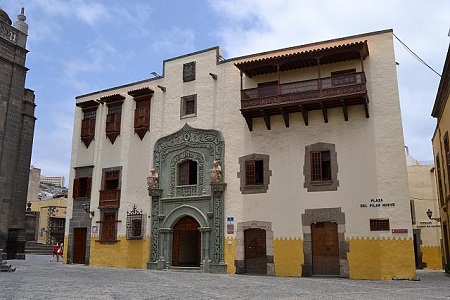 Gran Canaria´s part in the discovery of America gave way to the creation of the house-museum, which was built over the original House of the Noblemen. The ground floor and the well date from the 15th century, as does the elaborate, gothic facade of yellow stone. Columbus´ House explains the adventure of the Discovery of America by way of all sorts of pedagogical, didactic and ludic resources, which try to recreate the atmosphere of the era. Inside the house there are differentiated areas and spaces for the Provincial Museum of Fine Arts with its collection ceded from the Prado Museum. The building also contains a workshop for restoration. Check their website ATLANTIC CENTER OF MODERN ART: (CAAM) Tue - Sat 10:00 to 21:00 Sun 10:00 to 14:00 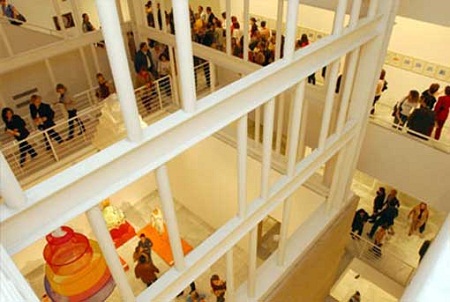 This characteristic building of Vegueta has been changed architecturally. The patio of the building has been transformed to become the central element where the views and perspectives captivate the visitor. The neoclassical mansion had its interior transformed to create three areas for exhibitions and a basement where the artistic works of the Cabildo Insular (town council) are stored. This exhibition center was inaugurated in December 1989 with the idea of increasing the tri-continental spirit of the islands- Europe, Africa and America.Check their website for exhibitions. THE CATHEDRAL of SANTA ANA 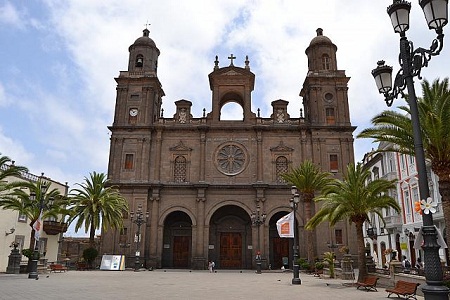 Diego Alonso De Montaude began construction in the year 1500. Four other architects followed him until the construction was interrupted in 1570. The part that was finished was of a gothic style in which blue stone was used for the arches, pillars and ribs. The vaults were built with a lighter more porous stone and yellow sandstone was used for some parts of the facade. The cathedral occupies 7000 square meters with a facade of 100 meters. The temple is laid out like a basilica: three aligned cannon vaults of more than twenty meters high, held up by ten columns and some twenty pilasters; there are ten chapels amongst them and another two in the wings of the transept. In 1533, the first facade and the primitive towers with octagonal bases similar to those of the basilica in Teror were built. The choir stalls, pulpits and altarpieces were burnt and sacked by the Dutch lead by Pieter van Der Does in 1599. At the end of the 18th century the work was started again and the transept with three main arches was finished as well as the dome, the main chapel, the vestry, the flat vault of the crypt, the back facade and the Sala Capitular among other rooms. Lujan Pérez finished the choir stalls and the images of the dome and started the facade. In 1852 Isabel II asked Pedro Maffiote to finish the main facade. At the end of the 19th century and the beginning of this century, the intricate circular window, the work of Arroyo, the towers and the small temple situated on the facade were carried out. Of the neoclassical works, the side chapel on the northern side had to be finished. The main altarpiece is gothic dating from 1518 and comes from the school in Seo de Urgel (Lerida). It was bought and installed in the 1920´s. In front of the altarpiece hangs a silver Genovese lamp donated in 1678. DIOCESAN MUSEUM OF SACRED ART Mon - Fri 9:00 to 13:30 14:45 to 17:00 Sat 9:00 to 13:30 This museum is situated beside the Cathedral, where religious figures of alabaster and wood from the 16th to the 17th centuries are preserved. The Patio de los Naranjos (Orange Patio), work of the 17th century is between the Cathedral and the Museum. The Canary balcony of teak and the fountain, both from the 18th century, are the main pieces in the patio. EPISCOPAL PALACE 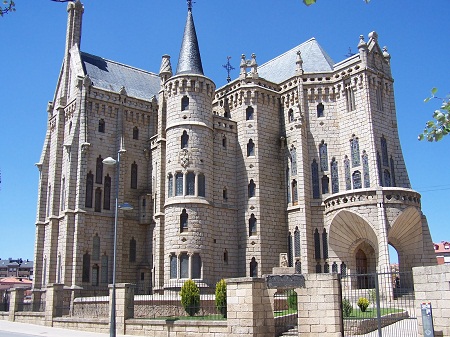 CASA CONSISTORIAL (COUNCIL HOUSE) Built in 1515, Las Palmas was the first municipality of the Canary Islands. The building that was constructed in 1525 and held the Ayuntamiento (city council), the Cabildo (town council) and the Audiencia (court), the history of the city and the island had been written and preserved until the night of the 29th March 1842, when a fire, which was provoked, destroyed everything. The public archives of the islands and various centuries of history were lost. A few days after the fire and due to the donations of the citizens, the building of a new Casa Consistorial was begun. Today, only weddings and council meetings are held. Espíritu Santo (Holy Spirit) On the left-hand side of the Santa Ana plaza there is the pillar of the Espítitu Santo, a work of art of the 19th century recently reconstructed. What was left of the chapel of the Espítitu Santo after the Dutch attack was moved from Triana to where it is found today. In this temple the image of the Cristo del Buen Fin (Christ of the Good End) is venerated and it is the only image taken out in a night procession during Holy Week in the capital. It has one of the most important religious brotherhoods of the locality. CANARY MUSEUM Mon-Fri 10:00 to 17:00 Sat/Sun 10:00 to 14:00 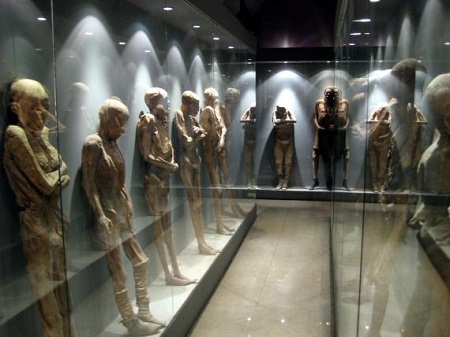 IGLESIA DE SANTO DOMINGO This building dates from the 18th century. It has three naves and two side chapels. The facade shows a portico and a blue stone belfry with the distinctive of the Dominican order. The rest of the facade is of masonry. There are numerous pieces of work by the sculptor Luján Pérez. On the altar to the right there is the Dolores and Saint John and an image of Christ carrying the Cross. In the other altarpiece to the left, which has 16th century elements, is Santo Tomás de Aquino. La Veronica is in the chapel of San José with the main altarpiece, which is rococo. On the side altar, El Señor Predicador can be found in front of La Virgen del Rosario. In front of the main altar is the Sala Capitular, topped by the organ. The choir stalls and musicians area is to the sides. IGLESIA DE SAN FRANCISCO This is situated in the Alameda de Colón. In its interior there are numerous of the most important, preserved religious images of the city, amongst which are ElSeñor del Huerto, San Pedro and San Juan by the image sculptor Luján Pérez. There is also a byzantine image, representing El Señor de la Humildad y de la Paciencia and La Virgen de la Soledad. Despite the Franciscan origen of this church, it is one of the most ostentatious of the capital, the walls are decorated with silver etchings of La Via Crucis. HOUSE-MUSEUM OF PÉREZ GALDÓS 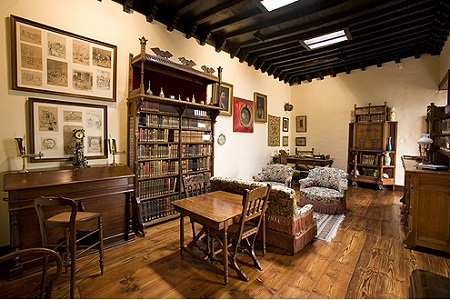 NÉSTOR MUSEUM The figure of Néstor Martín Fernández de la Torre exceeds the limits of his success as an artist and becomes integrated in the conception of an ideal touristic model in the island that tries to insert art into the social life. His varied works go from illustrations to furniture. He also designed clothes, did interior decorating, etc.. His most important stages are shown in three rooms. In the room on the other side of the hall are the early works of the painter, done between the ages of 12 and 17. In the second room there is the work called Epitalamiotom, subtitled Las Bodas del principe Néstor (the wedding of the prince Nestor)(1909). In this room there are also two glass show cases, designed by him, in which there are various of his personal objects. The third room contains the work called El Poema del Atlántico (the Atlantic poem) plus two series of four paintings. There is a room for portraits. In another room, dedicated to industrial arts, one can appreciate the great capacity for creation and the level of Néstor´s designs from posters and carriages to jewellry . There is a work which represents his conception of the typical costume, a tapestry titled Cortejo de la tradición (Entourage of Tradition) which represents a wedding in Teror, according to his own views. Lastly, there are the Visions of Gran Canaria, a personal proposal for the local touristic architecture which is reflected in the scarce public works: the Pueblo Canario, the Parador Nacional de la Cruz de Tejeda and the Tourist office in the Santa Catalina Park. ELDER SCIENCE & TECHNOLOGY MUSEUM Mon-Sun 10:00 to 19:00 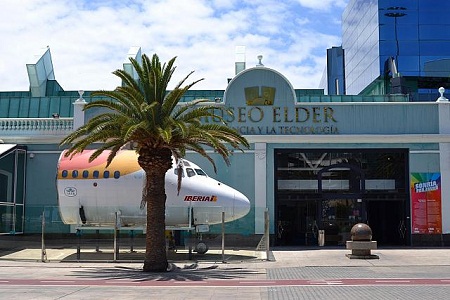 Located in Parque Santa Catalina and 6,800 square meters in size this museum has an exhibition surface of 4,500 square meters. The main theme here is to get the visitor curious! and they do this quite well with their catch-phrase "PLEASE, DO TOUCH". Of the 220 exhibitions, 200 are interactive. Set over four floors, with areas such as the Xploratorium; the International Space Station; a reproduction of ecosystems and demonstrations of cutting edge growing technologies; a multimedia projection room; computer science, telecom and meteorology areas. CASTILLO DE LUZ Mon-Fri 10:00 to 13:00 and 18:00 to 21:00 Sat/Sun 10:00 to 14:00 Built in 1494, shortly after the conquest, it is the most important defensive construction on the island. When it was first built, it was on a reef seporated from theisland by the high tide. For many years, it was the only fortification of the city, and according to records it convinced some pirates not to approach the island. In the last years, the developement of the port has led to reclamation of land from sea, the reason why La Luz Fortification is now surrounded by buildings and streets, and is no longer isolated by the sea. In 1941 it was declared a National Historic Monument and nowadays, ahaving been restored, this fortification is a cultural centre and a national and even international exhibition hall. ISLAND GOVERNEMNT OFFICE 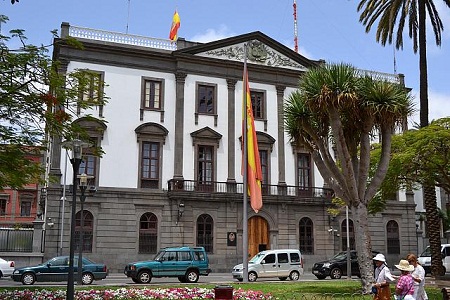 The origional building was constructed in the first half of the 16th century. In 1842 it was destroyed by fire but 14 years later, the municipal office opened it's doors again in the present neoclassical building, conceived by Manuel Gonzalez Gonzalez. Municipal services occupied this seat until the beginning of the last quarter of the 20th century. They were then moved to the Hotel Metropole which is situated in the district of Ciudad Jardin. From then on, this building, the Casa Constitoriales have been used to hold the plenary sessions of the Corporation and the representative functions of the Municipality. CASA REGENTAL The Govener's House! Situated near Casa Constitoriales, it is one of the noble buildings in the ancient Plaza Mayor of las Palmas that still remain. It dates back to the 16th century. It has one of the few ground plans portraying the characteristic features of the Renaissance style that has been kept. Inside the house worthy of note is its beautiful courtyard that stands among the others in the historic part of the city. Keeping its tradition, the Casa Rentigal is the seat of the presidency of the High Court of Justice to the Canaries. |
|